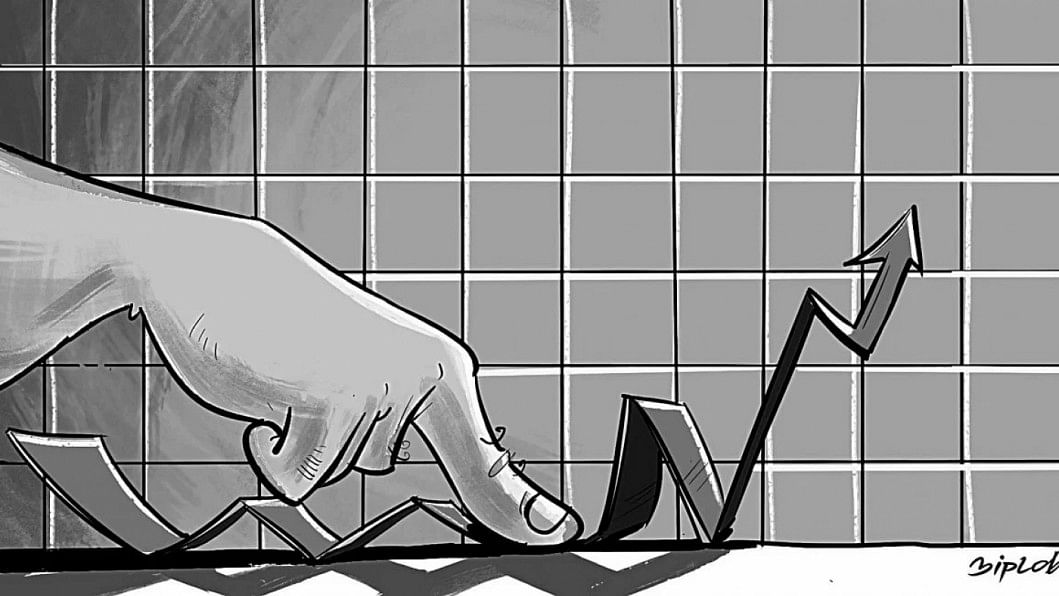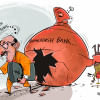How can Bangladesh avoid a middle-income trap?

In a recent visit to Bangladesh, the World Bank's leadership urged the country to take concrete steps to avoid falling into the so-called "middle-income trap". Similar concerns have been raised by economists in local think tanks such as the Centre for Policy Dialogue (CPD). No doubt, this matter is increasingly coming to the forefront as Bangladesh is now all set to graduate from the Least Developed Country status.
The concept of a "middle-income trap" is usually credited to Indermit Gill, now chief economist at the World Bank, and Homi Kharas from the Brookings Institution. They argued that rapid transition from low-income to middle-income country status which is often driven by cheap labour and export-driven economic models, is likely to be followed by prolonged low growth rates. Their intuition is simple. As wages rise, these "newly minted" middle-income nations suffer from reduced competitiveness in producing labour-intensive goods (e.g., garments) because their wages are now too high relative to other low-income countries, nor can they compete with high-income nations that have far greater levels of technology and innovation. As a result, these economies experience sustained growth slowdowns and rising informal economies. The economic struggles of countries in Latin America are often cited as proof of the middle-income trap.
As economists, we attempt to understand empirical patterns such as those observed in Latin America through formal economic theory. However, we continue to disagree on a convincing growth theory that would help policymakers better understand the transition from a middle to a high-income country. Perhaps this has led to different and somewhat arbitrarily defined approaches to measuring the existence of the middle-income trap for a given country while leaving some questions unanswered. For example, is a country caught in a middle-income trap if the factors that cause a slowdown in growth (e.g., higher wages, global recessions) are different from the factors that sustain slow growth (e.g., corruption, poor macroeconomic policies)? Does the middle-income trap even matter if a country's GDP growth is just enough to "technically" stay out of the trap, but the economy suffers from rampant inequality? After all, Bangladesh's statistical bodies are notorious for inflating growth figures, so staying out of a trap should not be too difficult from a purely mechanical sense.
Does the middle-income trap even matter if a country's GDP growth is just enough to "technically" stay out of the trap, but the economy suffers from rampant inequality?
The middle-income trap is meaningful if we think about it in terms of the structural factors preventing steady progress instead of just the number of years a (middle-income) country experiences slow growth. It reflects a fundamental inability to shift towards sustained levels of high growth rates because domestic productivity and technology relative to advanced countries are too low. Make no mistake: this is the defining feature. Even though global economic shocks can slow down progress, if an economy has high levels of productivity, it will always revert to its expected long-run trend. The absence of innovative capabilities that allow an economy to shift towards higher value-added activities is the key reason why many countries have failed to transition towards a high-income economy. As such, creative destruction is the way forward for Bangladesh as well.
So where does Bangladesh stand in charting a technology-driven journey towards high middle-income status in 2031 and developed country status by 2041? The short answer is we have a tough road ahead. If the economic transformation of South Korea is any guide, a true journey to higher income brackets must be characterised by far greater domestic resource mobilisation, rapid industrialisation, high-quality education, and careful macroeconomic management that is free of political intervention.
This is a lot easier said than done. Bangladesh's tax-GDP ratio is among the lowest in the world, which naturally constrains private investment. The less said about the education sector, the better. Several industries such as information and technology, finance, real estate, and even garments suffer from lack of skilled human capital. As a result, foreign workers are hired to fill the void. A report by this daily suggests that these foreign workers remit approximately USD 6 billion back to their home country every year, which is about one-fifth of our foreign exchange reserves. It is astonishing considering how many workers Bangladesh sends abroad every year because they could not find jobs at home. This is nothing short of a market failure stemming from below-par education that fails to equip the domestic labour force with the appropriate skill set. Effective education will require a complete rethinking of the way we train our students, in addition to higher budgetary allocations.
But the story does not end there. Macroeconomic management, while overall prudent, still needs to be far more progressive to transform Bangladesh into a productivity-driven economy. Several years ago, I had written on the rising global trend of exporting intermediate goods ("Trade policy: World racing ahead, Bangladesh standing still", The Daily Star, 2015). Fuelled by the fragmentation of production processes across different countries, many developing economies have substantially increased their exposure to global value chains (GVC). Participating in GVCs accelerates productivity, foreign investment, job creation, technological progress, and skill acquisition. Herein lies the need for a more outward-looking trade policy that goes beyond thinking about ways to just protect inefficient domestic producers. Finally, we all know the domestic financial sector is severely underdeveloped while the banking system has suffered from numerous scams that exacerbated the misallocation of resources.
One encouraging pattern I observed recently is the rising trend of venture capital (VC) investments in Bangladesh. VC investments typically come from seasoned global investment managers who spot promising opportunities in early-stage firms typically in sectors such as information and technology, consumer services, and health care. Moreover, VC investors typically bring institutional knowledge of best practices to grow a young business. Because young firms typically do not have the type of collateral needed to secure bank debt (e.g., machines, real estate), many promising startup ideas can never see the light of day. One must wonder if regulation can become more open to allow credit to flow to these sectors that carry tremendous long-term potential. For example, in the United States, banks can make direct private equity investments in startup tech firms, subject to careful credit appraisal of expected cash flows.
At the heart of it all, regulators must be willing to adopt a vision for Bangladesh that is more technology and productivity based. Not only do these challenges require new policies, but stronger institutions. Unless we accept that what worked before will not work in the future, achieving a sustainable growth path with shared prosperity will become a very daunting task.
Dr Sharjil Haque is an economist based in Washington DC. Views expressed in the article are the author's own.

 For all latest news, follow The Daily Star's Google News channel.
For all latest news, follow The Daily Star's Google News channel. 










Comments